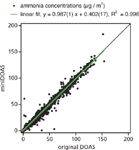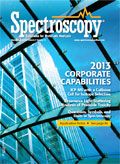The miniDOAS: Low Cost, High Performance Contactless Ammonia Measurements
The miniDOAS: Low Cost, High Performance Contactless Ammonia Measurements
Knowledge of atmospheric ammonia concentrations is important, but ammonia is difficult to measure. We report here on the development of a low-cost ammonia measuring differential optical absorption spectroscopy (DOAS) instrument, based on a small sized and low priced spectrograph.
Emissions of ammonia to the air cause environmental problems. Excessive deposition of this ammonia leads to acidification and eutrophication, which threaten the biodiversity in nature areas. Ammonia also plays an important role in the formation of aerosols. In order to come up with effective mitigation strategies, it is important to understand the processes that determine ammonia emissions.
However, ammonia concentrations are difficult to measure. Most available techniques are sampling techniques and therefore involve direct contact of the highly adhesive ammonia with tubes or filters. This causes problems, such as slow response times, and interference by dissociating ammonium aerosols. Therefore, at RIVM (the Dutch National Institute for Public Health and the Environment), we developed a new system based on the differential optical absorption spectroscopy (DOAS) technique.
DOAS: Differential Optical Absorption Spectroscopy
A DOAS system consists of a light source and a detector, with an open path in between. The detector measures a spectrum of the light that passes through the open path. Any gas present there will leave its spectral fingerprint on the measured spectrum. The amount of light absorbed is proportional to the amount of gas present. Note that the gas never comes into contact with any part of the instrument.
We modified a commercially available DOAS system to improve its performance for ammonia measurements. We selected the spectral window from 200 to 230 nm, because ammonia has a number of distinctive absorption lines in that region. The system performed excellently: it had a high up-time, low maintenance needs, a high resolution of 0.15 µg/m3 and it showed no interference or delay effects.
A Low-cost DOAS
Disadvantages are its high price of about € 200 000, its size and its complexity. Therefore we designed a DOAS instrument that was as small and simple as possible. Key to its design is its spectrograph, an Avantes AvaSpec-2048×14. This has a small footprint that enabled us to place it in the primary focus of the receiver telescope. The original instrument uses an optical fibre to couple the light into the spectrograph, which introduced a large loss of light. This loss was eliminated in the redesigned DOAS. This, combined with a more efficient light source, made it possible to use a much simpler and much smaller telescope. The DOAS shrunk from about 180 × 50 × 60 cm to 60 × 35 × 20 cm, with the parts summing up to about € 15 000.
Performance
This miniDOAS was extensively tested and compared to the original DOAS, both in the laboratory and in a field campaign. It is a very stable instrument: during a four-month measurement period, no realignment of the optics was necessary. It had a high resolution of 0.07 µg/m3. The measured concentration values of the original DOAS and the miniDOAS compared excellently. See Figure 1.

Figure 1: Ammonia concentrations compared measurements with the original DOAS and with the miniDOAS agree excellently. The plot is based on 13903 live minute values.
Conclusions and Outlook
We successfully developed the miniDOAS, a small and low-cost DOAS instrument to measure atmospheric ammonia concentrations. Its performance compared excellently to an existing DOAS instrument. This good performance of the miniDOAS was possible because it featured a more efficient light emitter and receiver. The low cost of the instrument makes it possible to incorporate it in automatic air quality monitoring networks and to use it for ammonia deposition studies.
Avantes BV
Oude Apeldoornseweg 28, 7333 NS Apeldoorn, The Netherlands
tel. +31 313 670 170; fax: +31 313 670 179
Email: info@avantes.com; Website: www.avantes.com

Thermo Fisher Scientists Highlight the Latest Advances in Process Monitoring with Raman Spectroscopy
April 1st 2025In this exclusive Spectroscopy interview, John Richmond and Tom Dearing of Thermo Fisher Scientific discuss the company’s Raman technology and the latest trends for process monitoring across various applications.
A Seamless Trace Elemental Analysis Prescription for Quality Pharmaceuticals
March 31st 2025Quality assurance and quality control (QA/QC) are essential in pharmaceutical manufacturing to ensure compliance with standards like United States Pharmacopoeia <232> and ICH Q3D, as well as FDA regulations. Reliable and user-friendly testing solutions help QA/QC labs deliver precise trace elemental analyses while meeting throughput demands and data security requirements.